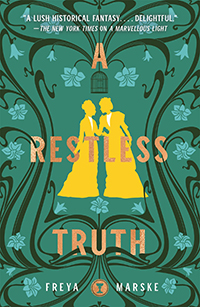Sylvie Cathrall’s A Letter to the Luminous Deep is a poignant epistolary adventure set in an underwater landscape filled with academics, explorers and artists. Through letters, log entries and other documents, various narrators describe their society, their passions, their families and, most importantly, the mysterious disappearances of eloquent recluse E. Cidnosin and the socially anxious yet brilliant scholar Henerey Clel. The primary correspondence takes place between Sophy, E.’s sister, and Vyerin, Henerey’s brother, who have bonded through their shared grief and wish to learn more about what actually transpired between their siblings.
Cathrall’s whimsical water world is filled with remarkable settings like the Cidnosins’ Deep House, a home well below the ocean’s surface that is as mysterious as it is beautiful, and academic institutions such as the Boundless Campus. Each character’s voice is distinct, and readers will blush and giggle along with Sophy and Vy as they track E. and Henerey’s relationship as it evolves from friendship into passionate love. One of the most memorable aspects of the book is watching Sophy and Vy’s own relationship grow. While Sophy is insatiably curious about E.’s past, Vy is a bit more cautious when it comes to learning more about his brother. As Sophy and Vy realize how important this shared cause is to them, readers get to see them develop their own wonderful friendship.
While the plot largely focuses on love both romantic and familial, the elegant letters hold sinister memories as well, clues leading up to the seaquake that shattered Deep House, after which E. and Henerey disappeared. There are many secrets to uncover, from a mysterious object found just outside Deep House, to E. and Sophy’s strained relationship with their brother, Arvist, to Sophy and her wife’s discoveries in the Ridge, home to deep-sea monsters. It’s up to Sophy and Vy to put the pieces together to heal the hearts and souls of their families and themselves.

















